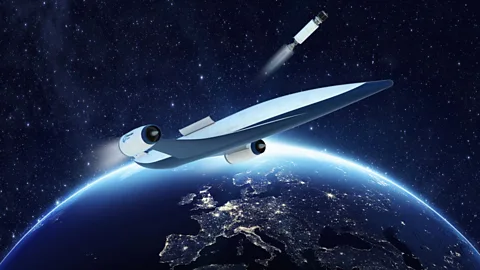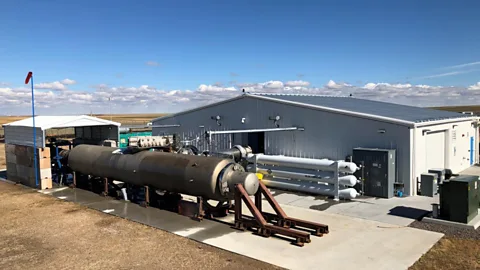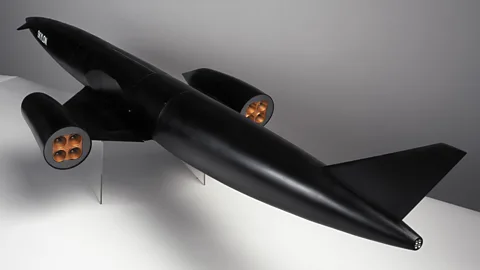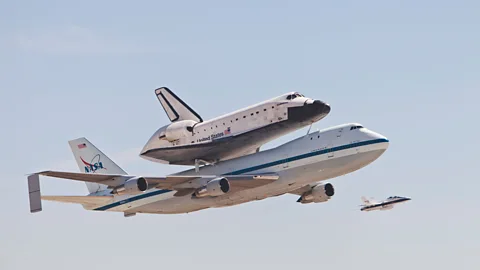Spaceplanes: The return of the reusable spacecraft?
 Reaction Engines
Reaction EnginesThe reusable spaceplane concept seemed to die with the end of Nasa's Space Shuttle. Could the spaceplane rise again in the 21st Century?
The dream of flying all the way into space began when the first aircraft flew at Kitty Hawk, North Carolina, in 1903. Less than 70 years later, we had a thoroughly realistic example of what that might look like. In Stanley Kubrick's 2001: A Space Odyssey (1968), a large spaceplane maneuvers effortlessly in time with Strauss's Blue Danube waltz to dock with a huge spinning space station.
Despite many plans, prototypes, and experimental flights since, only two spaceplanes have ever entered service, the Space Shuttle and the top-secret Boeing X-37B. Only the small, unmanned Boeing remains in service.
The dream of the graceful spaceplane is still live, even if the ambition for their actual role may have shrunk. In September 2020, China appears to have launched its own Boeing-like reusable space plane and may have as many as seven crewed and non-crewed spaceplane projects in development. The European Space Agency's similar autonomous Space Rider flying laboratory is expected to blast off in 2023 and India's own mini spaceplane later this decade.
But we still rely on rockets to blast astronauts into space, bringing them back to Earth in capsules suspended by parachute. So why has the spaceplane – apart from Nasa's now-retired Space Shuttle – not yet taken off?
One answer to this question can be found at a test site 2,900km (1,800 miles) away from Kitty Hawk at the foot of the Rocky Mountains in Colorado. The facility at the Colorado Air and Space Port was purpose-built by Reaction Engines to run "hot tests" of the technology that the company's revolutionary new rocket engine depends on. Tests that were backed by the US government's secretive Defence Advanced Research Projects Agency (Darpa).
Reaction Engines is a British aerospace company founded by engineers Alan Bond, Richard Varvill and John Scott in 1989 after the cancellation of the British spaceplane project Hotol. Its aim was to create Hotol's successor, the ultra-sleek, single-stage-to-orbit spaceplane Skylon, together with the engine that would power it. The Synergetic Air Breathing Rocket Engine (Sabre) is a hydrogen-powered engine that can propel a spaceplane like Skylon from zero to hypersonic speeds by using the oxygen in the Earth's atmosphere, and then when travelling fast enough, blast the vehicle into space using an on-board supply of oxygen like a conventional rocket.
You might also like:
Today they are backed by big names in the industry, including Boeing, British Aerospace and Rolls-Royce, as well as the UK and European space agencies.
Beyond the security fence, a modified engine from a Cold War-era fighter jet is used to replicate the very high temperature airflow generated at hypersonic speeds. The superheated air is blasted through a light-weight, ring-like device made up of thousands of thin-walled tubes through which coolant is passed. The aim of this precooler is to remove the extreme heat very quickly. When used in the Sabre engine, it's hoped it will prevent its internal components melting in the high temperatures and ensure the engine runs efficiently.
Early in 2019, the precooler had worked at 420C (788F) in conditions that replicated flight speeds of Mach 3.3, or more than three times the speed of sound. But the engineers wanted to reach the magic number of Mach 5. That is more than 6,200 km per hour (3,800 mph). It is also more than twice as fast as the cruising speed of Concorde and over 50 percent faster than the SR-71 Blackbird aircraft – the world's fastest jet-engine-powered aircraft. Mach 5 also happens to be the limit of today's materials used in aircraft production.
 Reaction Engines
Reaction EnginesAt Mach 5 and an altitude of 20km (12 miles) Sabre stops breathing the air, closes it inlets and starts to burn liquid oxygen mixed with its hydrogen fuel to reach speeds of Mach 25 which allow it to go into Earth orbit.
In October 2019, the record was smashed, and Mach 5 was reached. The precooler successfully "quenched" air flowing into the machine at more than 1,000C (1,800F) in less than 1/20th of a second.
The success of the test earned team leader Helen Webber the Royal Aeronautical Society's prestigious Sir Ralph Robins medal for engineering leadership, and the wider team a haul of awards. "We achieved something that has never been done before," says Webber. "This was a major moment in the development of a breakthrough aerospace technology. This success moves us one step closer to the realisation of Sabre and paves the way for hypersonic flight."
Now Webber is working on the core of the Sabre engine itself. While we may have to wait 10 years for flight trials of the engine to begin, their innovative heat-management technology looks set to be applied to other areas. In electric cars, for example, new efficient light-weight heat exchangers will make lithium batteries charge faster and last longer.
"Reaction Engines are doing a nice job of saying we are going to develop this technology first, and then this one," says Christopher Combs, University of Texas at San Antonio. "It is easier to pitch heat exchangers to investors which can be used in a jet fighter in five years than pitching the Skylon and saying it will take 30 years to build."
Perhaps oddly, it is hard to find mention of Skylon on the Reaction Engines website. "Skylon was the concept vehicle to show how the Sabre engine could be used," says Oliver Nailard, the business development manager at Reaction Engines. "We are not developing a vehicle. In the near term we are focused on the engine, but at the same time, we have to make sure that the space vehicle technologies are being developed alongside it."
 SSPL/Getty Images
SSPL/Getty ImagesTo this end, Reaction Engines work with "different interested parties" who might build a spaceplane. In 2020, the company worked with the ESA on a more conservative concept of a two-stage vehicle to be launched from French Guyana in the next decade.
The concept of a spaceplane is simple, though it has been attached to a confusing array of vehicles. A very loose definition could mean that the Boeing 747 that launched Virgin Orbit's LauncherOne is classified as a spaceplane because it is the equivalent to a spacecraft's first stage.
There are two types of "real spaceplanes", says Jean Deville, the Shenzhen-based author of the China Aerospace Blog, and co-host of a podcast about Chinese aerospace and technology, Donfang Hour. "The easiest version is when the spaceplane is blasted into space on the back of a traditional vertical take-off rocket, like the Space Shuttle. The hardest is when the launch vehicle takes off horizontally and reaches space by a progressive trajectory, or when both stages are spaceplanes, like China's Tengyun concept."
It is easy to list the advantages of spaceplanes. There is the compelling idea of "flying" to a space station and back just as we fly in an airliner from New York to San Francisco. There is the ability of spaceplanes to use runways rather than requiring expensive launch pads, which also means they can be launched and landed more often. And if you want to a retrieve a satellite, then a spaceplane – and not a crewed capsule, returning to Earth via parachute – is the only solution.
Spaceplanes can also be used to test military equipment, and even to intercept enemy satellites. The technology of spaceplanes overlaps with that of hypersonic weapons and aircraft. For this reason Reaction Engines is a member of a research programme funded by the UK Ministry of Defence to develop hypersonic propulsion systems for aircraft.
Unfortunately, the space industry hasn't evolved in the way that spaceplane advocates wanted. "We have made far more progress with computers than rockets," says David Burbach of the US Naval War College, Rhode Island. "Automation means that we really don't need to send many people into space. It may seem primitive, it may seem undignified, but rockets are actually all we need at the moment."
 Peter Kovalev/TASS/Getty Images
Peter Kovalev/TASS/Getty ImagesThere is also, some analysts believe, little demand at the moment to bring satellites back to Earth because they have become cheaper to build, longer lasting and, frankly, disposable. Space X's Starlink satellite constellation uses thousands of mass-produced small satellites to expand internet access.
And spaceplanes involve expensive technological challenges. Materials are needed that are tough and light enough to survive frequent return trips to space, and there is the problem of integrating the two or three different types of propulsion systems needed for different stages of the flight. "This is, in my opinion, one of the major difficulties," says Deville.
"Ultimately, the main obstacle to spaceplane projects is that the development requires very deep pockets," he adds. "This is why Europe and the USSR and Russia walked away from the concept."
Then there is the competition. "SpaceX has a reputation for pushing a lot of boundaries, but it is killing the spaceplane," says Combs. "They are doing such a good job of making space access cheap it's eliminating the motivation to invest in expensive spaceplane research."
It may be that only a billionaire can tolerate the cost of failure involved in developing a spaceplane.
Despite the recent success of the Boeing X-37B in a niche military role, spaceplane fans are used to disappointment. Russian-Soviet spaceflight pioneer Friedrich Zander designed an interplanetary spaceplane in 1911 with wings designed to burn off during its ascent. In the 1930s, Austrian engineer Eugen Sänger came up with the idea of a rocket-powered suborbital bomber to bomb New York. Thankfully, the Nazis never produced it.
In the 1950s, rocket designer Wernher von Braun set out his vision for a "rocket with wings" in Collier's magazine and the US Air Force dusted down Sänger's idea. The Boeing X-20 Dyna-Soar (yes, it was called that) was cancelled in favour of the Gemini programme. The original Gemini spacecraft was supposed to blast into space on a rocket and land on a runway like a paraglider, until that too was cancelled. Once-secret Soviet projects also failed. The MiG-105, for instance, was a crewed test vehicle developed for an on-off Soviet plan to build a spaceplane. It first flew in 1976, but the Experimental Passenger Orbital Aircraft (Epos), as the project was named, was finally cancelled two years later.
 Ted Soqui/Corbis/Getty Images
Ted Soqui/Corbis/Getty ImagesThen every nation wanted its own spaceplane. Inspired by Nasa's Space Shuttle, the Soviet Union's Buran flew one uncrewed spaceflight in 1988, before the programme was cancelled. Plans for European and Japanese spaceplanes stayed just that – plans. China's intent to build its own spaceplane was shelved because rockets were a quicker way into the space race. "China launched its first taikonauts into space in 2003 instead of a projected 2020," says Deville.
Despite the poor performance of the Shuttle, the US didn't stop dreaming of a reusable spaceplane. The futuristic Lockheed Martin X-33 or Venture Star was cancelled at an advanced stage owing to technical problems. Other top-secret programmes were rumoured to exist. Out of these projects the unmanned Boeing X-37B was born. Boeing's proposal for a larger, crewed version, was turned down.
"When I was a kid, I watched all these incredibly cool sci-fiction vehicles take off like an aeroplane and fly into space," says Combs. "It's the kind of aspirational technology that makes people want to be engineers and that engineers want to build, particularly when spaceplanes have been so tantalisingly close for such a long time."
So, is there then a future for the spaceplane?
The race to develop hypersonic aircraft and weapons may indeed help solve the technological problems that face spaceplane projects. Or the niche role played by the craft like the Boeing may be the best it gets. "Outer space is a place of crushed dreams and broken promises," says Bleddyn Bowen, University of Leicester, and author of War in Space: Strategy, Spacepower, Geopolitics. "Spaceplanes may simply provide a useful orbital testbed for new technologies."
However, one thing is certain. Whichever future the spaceplane does have, it will involve China. "We know very little about the launch [of China's experimental spaceplane]," says Deville. "But it shows that China is serious about developing its spaceplane concepts."
"In the end, people are looking for space access to go beyond what they can do today," says Reaction Engines' Nailard. "They are looking for the ability to launch on demand. And we need to move towards this aircraft model if we are to finally unlock the potential of space."
--
If you liked this story, sign up for the weekly bbc.com features newsletter, called "The Essential List". A handpicked selection of stories from BBC Future, Culture, Worklife, and Travel, delivered to your inbox every Friday.
